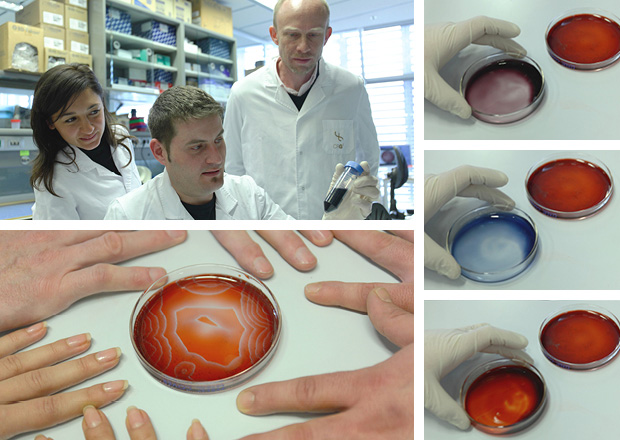Systems Biology Programme
CRG researchers demonstrate that the mathematical theory proposed by Alan Turing in 1952 to explain embryogenesis can, in fact, account for the formation of fingers.
For Boris Belousov, recognition came too late. Although he was the person who discovered the emergence of order as a spontaneous property of matter, a phenomena that is much more common than one would expect, he was disregarded by the chemistry community that considered his theories simply, well, impossible.

The story of this obscure Russian military chemist goes like this: in the 1950s he was working on certain chemical reactions when he noticed that a mixture of different products made the colour of the solution oscillate, generating spontaneously ordered patterns that changed over time. He was excited about his discovery and tried to publish it twice, but Russian chemical journals, claiming that he was not able to explain the reason why this phenomenon occurred, coupled with the fact that what he was suggesting was impossible, rejected him.
Some years later, in 1961, a graduate student named Anatoly Zhabotinsky took up this project. And he had better luck! Instead of sending the paper to a chemical journal, he tried a biophysical one and succeeded! He published their results in 1964 and today there is a vast quantity of scientific literature on Belousov-Zhabotinsky reactions. And many, many students have tested this surprising and beautiful reaction while at high school.
For Alan Turing (1912-1954), the British mathematical genius, things were not easy either. And one chapter of his story has some things in common with that of Belousov. Although best known for his contribution to laying the foundations of computer science, having provided the first formal concept of a computer algorithm, in 1952 this British mathematician published a paper on how an embryo develops and forms the different parts of the body. He suggested that this process, called morphogenesis, was ruled by a kind of mathematical and secret language that told identical cells when and where to make a finger, a brain or a lung.
He discovered that a system, a net of interactions, involving just two molecules could, at least in theory, create spotty or stripy patterns if they diffused and chemically interacted in just the right way. And that is exactly how it works in zebras or leopards, for instance. He developed mathematical equations which he used to demonstrate that, starting from a uniform condition, in this case a multitude of equal cells, these cells could spontaneously self-organise their concentrations into a repetitive spatial pattern. Perhaps, if he had not committed suicide two years after the publication of the paper, he would have thrown more light on biological mysteries.
60 years of denial
Since its announcement, Turing’s theory has been accepted as explaining fairly simple patterns such as zebra stripes and even the ridges on sand dunes, but for decades embryology has been resisting it as an explanation of how structures such as fingers are formed.
“There was another theory, more intuitive, based on positional information, proposed by Lewis Wolpert. This hypothesis states that each cell knows what it has to form because it is aware of its position in the whole limb. However the Turing system does not work like that; in his theory, cells have no clue about where they are and it is rather weird, and magical and difficult to understand, and that is the reason I think it was not widely accepted”, states James Sharpe, ICREA research professor and head of the Multicellular Systems Biology lab at the CRG.
Sharpe has always been on the side of those who were more in favour of Turing’s theory. “His paper on pattern formation seemed to me the most convincing”, the researcher explains. “So I decided to try to explore that as one part of the bigger picture of how the shape of limbs is created. And finger pattern was one part of that.” He started working on it a long time ago, in the 90s, while he was doing his postdoc, although from a totally theoretical angle. He explains that at that time, “my goal was to build computer model simulations of limb development as an example of organ formation.”
Sharpe’s first big step forwards was in 2012, when, in collaboration with a CSIC group based in Santander, he managed to shed light on how fingers are formed, and demonstrated that the process could be explained by the Turing biological pattern system. The work was published in the journal Science. Nevertheless, he still did not know what the Turing molecules were.
“We were proposing that genes regulated the Turing System, we provided evidence that Hox genes and FGF signalling modulated a hypothetical Turing system. But we did not answer the question of which genes in fact comprise the Turing system. And this was the critical unsolved piece of the puzzle”, says Sharpe. And it is precisely this that he and his team at the CRG have uncovered.
In their new study, also published in Science, they managed to complete the picture by revealing which signalling molecules act as the Turing system. To do this, they took a systems biology approach and combined experimental work with computational modelling in order to study how, at one particular moment, identical cells start differentiating to form a kidney, a leg, or a hand with five fingers. Sharpe’s team has discovered that there are three proteins responsible for the finger pattern: Bmp, Sox9 and Wnt.
Researchers believe that the same kind of system is also relevant for the vertebrae, as it, too, is a repeated periodic structure, like the fingers. But they are yet to study this.
The results of these findings shed light on how the millions of cells that form our body are able, during embryogenesis, to correctly generate 3D structures, like the heart or feet. Understanding how cells self-organise to form the body is essential for developing, in the future, strategies for regenerative medicine.
